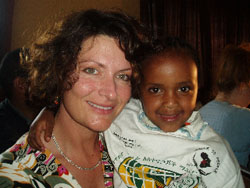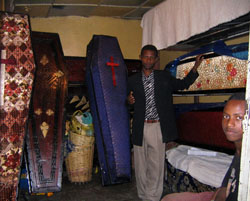Inspired to act
Inside a Temple scientist’s mission to study HIV in Ethiopia
| Some HIV patients suffer from terrible neurological disease. Others never have any cognitive problems at all. Both groups carry the same virus, but respond very differently. That’s why most days you can find Dianne Langford working in a lab on Temple University’s campus, researching how HIV affects the brain. Once a year, however, her research takes her around the world to Ethiopia. Ravaged by HIV, the nation has little capacity to treat those infected with the virus, including infants born to HIV-positive mothers. “An Ethiopian baby is born with an immune cell count as high as any other baby. But as they become adults, their cell count drops significantly below anybody else’s in the world, and we don’t know why,” says Langford, a Ph.D. and assistant professor of neuroscience and neurovirology at Temple University School of Medicine. “It’s |
 Photo courtesy of Dianne Langford
The face of hope: Langford with toddler Tefsanish, an AIDS orphan. Tefsanish is one of 650,000 children left parentless in Ethiopia because of AIDS. The non-profit People To People runs an orphanage to provide housing for kids, like Tefsanish, whose name means “hope” in Amharic.
|
|
a population with unique characteristics not found in other African populations or any other population in the world tested so far.” |
|
 Photo by Dianne Langford
Big business: A man sells coffins in the Addis Ababa market, a common practice on the streets of Ethiopia.
|
That’s why little is known about HIV-1C, a subtype of the virus. Though it accounts for more than 50 percent of HIV infections throughout the world, it is found only in Ethiopia, other sub-Saharan African countries and India. HIV-1C is very different from subtype B, the form of the virus found in the United States. HIV-1C may be different in its progression and how it affects the brain, which is why Langford focused on Ethiopia. For the past five years, she’s volunteered through the non-profit People To People, a non-governmental organization dedicated to easing the burden of the HIV/AIDS epidemic in Ethiopia and other sub-Saharan countries, but it’s a mission that happened more by chance than choice. “I was at an international NIH meeting in Baltimore in 2003 and people were giving Powerpoint presentations using all kinds of |
|
fancy graphics,” says Langford. “Then, a soft-spoken Ethiopian woman stood up and spoke about HIV in her home country. No presentations — just her own experiences. I was so impressed.” |
|